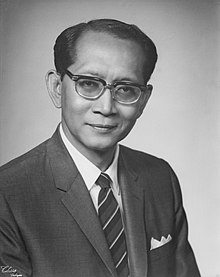
Back Soedjatmoko German Soedjatmoko ID Soedjatmoko JV Soedjatmoko MIN Soedjatmoko Dutch Soedjatmoko Sundanese
Soedjatmoko | |
|---|---|
 Official portrait, 1968 | |
| Rector of United Nations University | |
| In office 10 April 1980 – 30 March 1987 | |
| Preceded by | James M. Hester |
| Succeeded by | Heitor Gurgulino de Souza |
| Ambassador of Indonesia to the United States | |
| In office 5 May 1968 – 31 July 1971 | |
| Preceded by | Suwito Kusumowidagdo |
| Succeeded by | Syarief Thayeb |
| Member of the Constitutional Assembly | |
| In office 12 December 1956 – 5 July 1959 | |
| Personal details | |
| Born | Soedjatmoko Mangoendiningrat 10 January 1922 Sawahlunto, Sumatra's West Coast Residency, Dutch East Indies |
| Died | 21 December 1989 (aged 67) Yogyakarta, Indonesia |
| Political party | Socialist (1955–1960) |
| Spouse |
Ratmini Gandasubrata
(m. 1957) |
| Children | 3 |
| Relatives | Nugroho Wisnumurti (brother) Sutan Sjahrir (brother-in-law) |
| Education | Hogere Burgerschool |
| Occupation |
|
Soedjatmoko (born Soedjatmoko Mangoendiningrat; 10 January 1922 – 21 December 1989), more colloquially referred to as Bung Koko,[1] was an Indonesian intellectual, diplomat, and politician. He was born into a noble father and mother in Sawahlunto, West Sumatra. After finishing his primary education, he went to Batavia (modern-day Jakarta) to study medicine; in the city's slums, he saw much poverty, which became an academic interest later in life. After being expelled from medical school by the Japanese in 1943 for his political activities, Soedjatmoko moved to Surakarta and practiced medicine with his father. In 1947, after Indonesia proclaimed its independence, Soedjatmoko and two other youths were deployed to Lake Success, New York, to represent Indonesia at the United Nations (UN). They helped secure international recognition of the country's sovereignty.
After his work at the UN, Soedjatmoko attempted to study at Harvard's Littauer Center for Public Administration (now the John F. Kennedy School of Government); however, he was forced to resign due to pressure from other work, including serving as Indonesia's first chargé d'affaires in London for three months as well as establishing the political desk at the Embassy of Indonesia in Washington, D.C. By 1952 he had returned to Indonesia, where he became involved in the socialist press and joined the Socialist Party of Indonesia. He was elected as a member of the Constitutional Assembly of Indonesia in 1955, serving until 1959; he married Ratmini Gandasubrata in 1957. However, as President Sukarno's government became more authoritarian Soedjatmoko began to criticise the government. To avoid censorship, he spent two years as a guest lecturer at Cornell University in Ithaca, New York, and another three in self-imposed unemployment in Indonesia.
After Sukarno was replaced by Suharto, Soedjatmoko returned to public service. In 1966 he was sent as one of Indonesia's representatives at the UN, and in 1968 he became Indonesia's ambassador to the US; during this time he received several honorary doctoral degrees. He also advised foreign minister Adam Malik. After returning to Indonesia in 1971, Soedjatmoko held a position in several think tanks. After the Malari incident in January 1974, Soedjatmoko was held for interrogation for two and a half weeks and accused of masterminding the event. Although eventually released, he could not leave Indonesia for two and a half years. In 1978 Soedjatmoko received the Ramon Magsaysay Award for International Understanding, and in 1980 he was chosen as rector of the United Nations University in Tokyo. Two years after returning from Japan, Soedjatmoko died of cardiac arrest while teaching in Yogyakarta.
© MMXXIII Rich X Search. We shall prevail. All rights reserved. Rich X Search